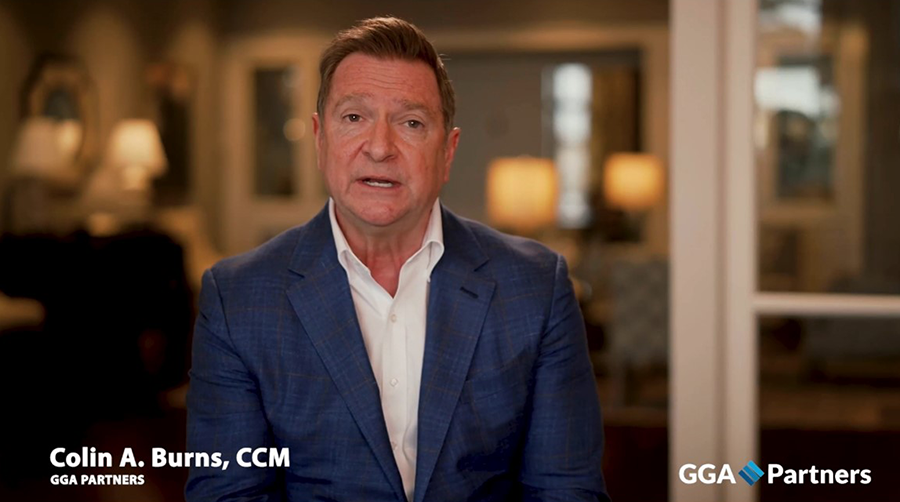
Lesson #7
of GGA Director Colin Burns’
31 years | 31 Lessons
Collaborative Leadership

Lesson #6
of GGA Director Colin Burns’
31 years | 31 Lessons speaks to
how to provide inclusive hospitality

The GGA Partners 31 Years | 31 Lessons featuring Colin Burns continues with explaining how coming from a place of goodness will be remembered.

GGA Director Colin Burns, CCM, brings his print ad to life in a new video highlighting his beliefs about the role of an executive search consultant.

GGA Director Colin Burns, CCM, shares his Winged Foot Golf Club lessons learned about the member experience.

Managing a private club is not an easy task. It requires knowledge, stamina, fortitude, patience and a sense of humor. With each new year comes new challenges, opportunities and lessons to learn.
When GGA Director Colin Burns, CCM, joined the firm, he shared the lessons he learned over a lifetime in the hospitality industry, as an advocate for club management and his three decades as the general manager of Winged Foot Golf Club with our team. In hearing those lessons, we were reminded how success comes from doing the right thing every day.
We asked Colin to record his common sense and professional advise for us to share with you. Today we present the first of Colin’s 31 Years | 31 Lessons videos. We will be releasing all 31 on our LinkedIn page over the next several months in the hope you find these lessons helpful as you navigate your own path to success as a leader in our industry.
In today’s world, where technology, media, and consumer demand intersect in a constant state of disruption, leadership starts with understanding and dealing with change. Henry DeLozier provides perspective on how superintendents can rise to the challenge.
Times have sure changed. Now you’re the one whom young men and women — the ones who aspire to your position one day — look to for guidance and assurance. And it’s in those hopeful faces, full of equal amounts potential and self-doubt, that your biggest challenge and the most important aspect of your job lies.
It’s called leadership. And in today’s world, where technology and media and consumer demand are intersecting in a constant state of disruption, leadership starts with effectively understanding and dealing with change. Among the biggest changes for golf course superintendents in the last decade:
If those are some of the major changes currently affecting the superintendent’s world, what might be over the horizon in terms of effective leadership qualities? From our perspective, it’s retaining your best talent. Although job-hopping in many industries has slowed this year as economic uncertainties weigh on employees, the situation could change as the economy and job market continue to improve, especially if employees aren’t feeling supported by their employer. It’s a challenge shared by your peers in organizations across the board.
“Employees crave a rewarding and purposeful workplace atmosphere. Now is the time for organizations to evaluate what is working well for their people, and what’s not resonating,” says Laine Thomas Conway of Alight Solutions, a global consulting firm. “When employees feel their employers are continually improving their offerings and working to enhance the employee experience, they are likely to remain positive and committed to their organizations, and in turn, employers can better retain top talent.”
In other words, says Tom Wilson, the CEO of Allstate Insurance: treat employees like customers. “They don’t pay you in dollars, but in hard work. That has led us to an employee choice model in the new world,” he says. Here are several tactical suggestions to help your team members:
It’s no longer enough to react to changes affecting our careers. To be an effective leader and to encourage your best players to remain part of the team, we must anticipate the next wave of change heading in our direction.
This article was authored by Henry DeLozier for Golf Course Industry magazine.
Game Plan – Henry DeLozier‘s monthly column in Golf Course Industry Magazine – continues its series on staffing for success with a review of the business bestseller “Leading with Gratitude: Eight Leadership Practices for Extraordinary Business Results.”
How does it make you feel when someone expresses their appreciation for a job well done? Pretty great, right? We can all remember the emotional high when a boss we respected told us how grateful he or she was for our contribution to a particularly meaningful project. As it turns out, beyond the personal boost gratitude provides, it’s also great for business. The multi-faceted benefits of gratitude is the subject of Adrian Gostick’s and Chester Elton’s business bestseller “Leading with Gratitude: Eight Leadership Practices for Extraordinary Business Results.”
After surveying more than 1 million employees, Gostick and Elton found that expressing gratitude is the easiest, fastest and least expensive way for managers to improve employee performance and engagement. In that sense, showing gratitude is not only about being nice — it’s about being smart because it could also uncover untapped employee potential and identify obstacles standing in the way of even better performance.
Maybe the best thing about practicing gratitude is that it’s easy. But that’s not to say that it comes naturally to all leaders or that it’s well understood as a business strategy. In many organizations, there exists a sizeable “gratitude gap” between the appreciation employees feel they deserve and what they receive.
This gap points to the consequences of an ungrateful work culture. The authors found that 81 percent of workers said they would work harder if their boss was more grateful for their work. And if you want to reduce turnover, start with gratitude. The No. 1 reason people leave a job, according to the U.S. Department of Labor: They don’t feel appreciated by their managers, even more of an issue with today’s younger workers.
Expressing gratitude effectively is an easily learned behavior, but it does require more, in the authors’ view, than “showering more thank-yous” on employees: “Developing genuine gratitude involves carefully observing what employees are doing, developing greater empathy and sincerely trying to understand the challenges they face.”
Some leaders will insist they are “not wired” for gratitude, excusing their command-and-control style with increased performance, production and results. But the authors insist just the opposite: “Leaders who infuse fear into their work cultures undermine their objectives to increase performance and instead produce stress that can lead to burnout and other productivity-crushing effects.”
Former Ford CEO Alan Mulally is among the many executives who back up the authors’ claims. “Skills are one thing,” he says, “but to create a smart and healthy organization, void of politics, whose people don’t go after each other, that’s about respecting them, showing them the data and thanking them for what they’ve done.”
In his first meeting with Ford’s 4,000 dealers, Mulally began practicing what he preached. He asked Ford employees in the audience to stand, turn and face the dealers. “Now say ‘We love you,’” Mulally instructed. It took the employees three tries before Mulally was satisfied with their sincerity and enthusiasm, but the dealers were quickly convinced this was going to be a new Ford under Mulally’s leadership, one where their roles were valued.
“We aren’t saying every manager needs to offer praise to every employee every day,” Gostick and Elton conclude. “We are saying that most managers should be offering more of it, quite a bit more often.”
This article was authored by Henry DeLozier for Golf Course Industry magazine.